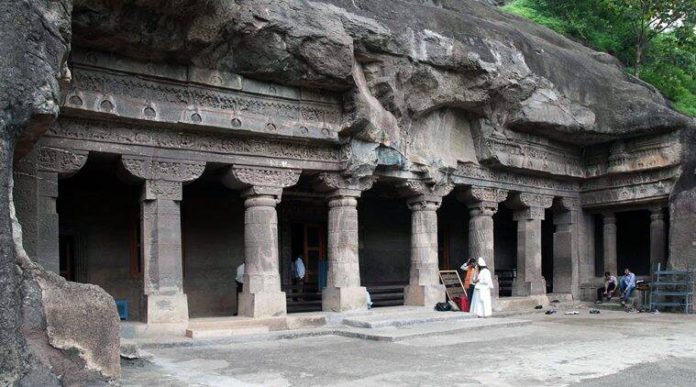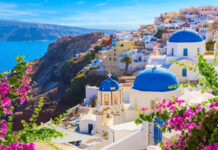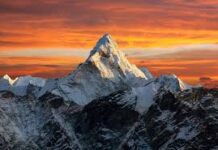Architecture is an art which has the power to develop aesthetic beauty.
Ajanta is a great art treasure. Its caves are fine example of rock cut architecture. They contain some refined sculptures, and more importantly, paintings of matchless beauty. Infact, the bright history of Indian painting starts from the wall paintings of Ajanta. Nowhere in the world such beautiful paintings were done during that period around second century. That’s why it is known as a golden period of Indian art.
Ajanta caves are the picture books of Buddha’s life and his teachings. Buddha’s intelligence, noble character, selfless service and compassion are illustrated on the glorious timeless walls of the Ajanta caves with the help of Jataka tales-the previous births of Buddha. The artists have represented different aspects of life painted in Ajanta caves. Lonely life of village, luxury life of courts, beggar, fisherman, fighting soldiers, birds and animals etc. are found in Ajanta paintings. The whole religious and philosophical life has been depicted in the background of these figures.
The unfoldment of the history of Ajanta caves bring about a series of facts. During the early stages, the followers of Lord Buddha constructed several Stupas, Chaityas and Viharas throughout India. The stories of past lives of Buddha known as Jataka stories, were painted in Bhaja, Karle, Kanheri and Ajanta.
In C. E. 1817, some tiger hunting British soldiers first saw this collection of caves lying deserted in a horshoe shaped narrow valley close to Aurangabad in Maharashtra. On a fateful day this year, the art of Ajanta was exposed to the fascinated world.
This holy pilgrimage of Indian painting settlement a huge amphitheatre is situated in Aurangabad district of Maharashtra state. There is a small hill of about 300 feet high in a crescent moon formation with a stream flowing nearby. These are actually the temples of art where expression of love, patience, worship, sacrifice, sympathy and peace in the form of architecture sculpture and painting are seen.
Ajanta is the only surviving example of painting in second century BC and 6th century A.D.
The story of these caves is unique. During the first phase, in the Hinayana period (2nd-1st centuries BCE), the earliest caves ( numbers 8, 9,10,13 and 15A) were painted during the rule of Satavahanas. The second phase of Mahayana period (4th-6th centuries CE) was of greater artistic activity at Ajanta and the remaining caves were painted during the rule of Vakataka dynasty. The rulers, Satavahanas, Vakatakas and Chalukyas were themselves Hindus but allowed Buddhism to prosper in their territory. The rich business community, organised the guilds and provided the required funds. The art mastered during Gupta period with fullest charm.
According to the scholars the paintings of Ajanta have unique classification of three types as regard to the subject matter and they are ornamental, emotional or expensive and descriptive. The first category includes animals,birds, flowers etc. Buddha in different poses, his birth, death, Bodhisattva, King and Queen come under second category. Third category consists of Jatakas and Avadanas- the stories and events of Buddha’s life.
Ajanta is marked with the presence of different types of caves. Firstly the chaitya of the Stupa Caves & secondly the Vihara caves which were living places for Buddha Bhikshus.
Ajanta is comprised of 29 chaitya and vihara caves that were incised into live rocks and are host to some of the best preserved paintings and sculptures.
Ajanta frescoes were done in tempera style. The surface of place where painting was to be done was made rough using some tools. A plastic containing stone powder, cow dung and rice straw was applied on that to a thickness of half to two inches. After applying plaster, the surface was beaten with flat bamboo sticks. After three or four layers of same plaster beaten every time with bamboo sticks, the surface was covered by a thin coating of lime paste which was treated like a painting surface. Then line drawings required for the painting were drawn with red colour on the surface where painting was to be completed while the surface was wet. After the first outlining of the composition, the painter would then define the subjects with undercoat of grey. After covering the whole surface as a finished painting with natural water soluble colours, the painter would again give a last polishing with a smooth stone to give a shine. In the end, finishing lines were made by black or brown colour.
The art of Ajanta caves are famous all over the world and have gained popularity on an appreciable level. Around 80% of tourists visit it. The paintings have a series of characteristics which attract the tourist on a large scale. Ajanta paintings are well known for their linear beauty where the expression of emotion are specialised by drawing lines which are powerful and flexible in nature. The Bhava- expression of sentiment is the very soul of Ajanta art. For example the Gaja Jataka story, human emotions like humour, peace etc. have been beautifully depicted in Ajanta art. Symbolic paintings of elephants, lotuses etc. have been painted as the symbols of well being. Continuous narration of sequence of events are depicted in the walls of these caves. There are mathematical techniques for correct drawings. Women in ideal form have been beautifully illustrated. Ceilings of Ajanta caves are beautifully decorated with God, goddesses, lotus etc. Bodhisattva Padma Pani is depicted as an enlightened being who is about to achieve final nirvana. Variety of life, divine and physical, royal to rugged, all levels of society have been nicely depicted. On one side Ajanta artists have depicted the delicate sentiments of relaxation, preaching and pity and on another hand crude battle scenes have been depicted. Portrayal of nature have been painted in rare artistic form which makes them real and full of life.
By Sarvagya Sanjay

















Well written and appropriate use of words at the right place.
Superb essay. Award winning. May be first runner up
Superb …
Excellent essay. Highly impressed. Just award winning
Nice
Thank you for providing a good knowledge about
Ajanta Caves …keep going
Wonderful dear
good read
Nice
Very inspiring
Historical Place
Very nicely written!
Very well explained.
The research, analysis, thoughts and efforts put by Sarvagya are well comprehended. Good work done.
Thanks for providing such a great information in such an easy way.
That’s incredibly well writen. I have a great fascination with Ajanta Caves and would love to visit them someday.
I’m Going To Vist Very Soon.. Wonderful Place
Very nice and detailed article on Ajanta cave and very well depicted about the glory of India.
Best wishes !
Very impressive…..and exclusive..
All points well mentioned… Great work ✌✌
Informative and well written.
A very informative and knowledgeable essay….
Very good sarvagya
Great write- up !
sc
Elucidated each thing nicely,splendid indeed nd may success be ur constant companion….
Excellent
What a beautiful explanation. ✨
Very informative
Highly impressed..
U r doing awesome…keep growing
Great